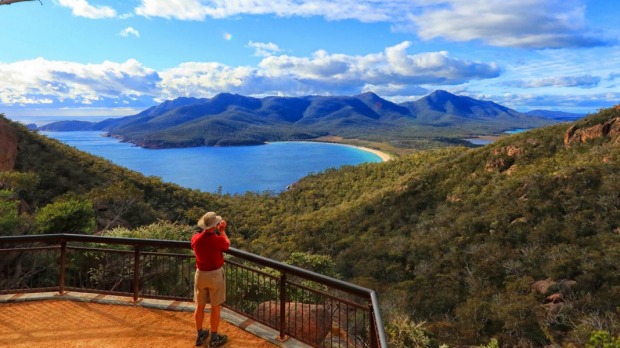
The sea was angry today, my friends. Not just piqued as she was yesterday or irritated as she will be tomorrow, but full-blown furious. We are copping heavy swells, gale-force winds and freezing temperatures and the common areas of Coral Expeditions I are deserted as we bounce our way down the south-east coast of Tasmania towards Maria Island.
Today – our fourth at sea – is the roughest so far and the rocking and rolling of the ship is accompanied by crockery tumbling from tables and regular reminders to use the handrails. It is only the call to evening drinks that rouses the passengers, and even then only the hardy.
This weather is part of the capricious nature – and the romance – of southern Tasmanian waters and we are getting an inner ear full of it on this seven-day cruise. As the sea switches from mightily riled to slightly miffed and back again, we are compensated every day by sublime coastline scenery and eclectic local attractions. And a lot of our time is spent anchored in calm bays or exploring on land.
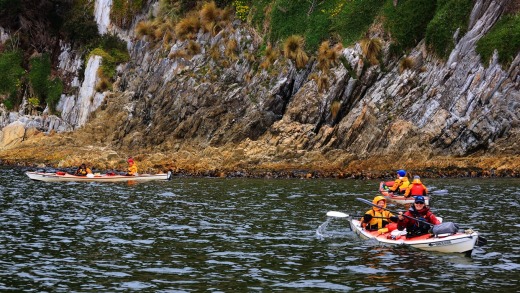
Small ship operator Coral Expeditions, which already runs Barrier Reef, Kimberley, South Pacific, New Zealand and Cape York and Arnhem Land tours, has recently added this new southern Tasmanian foray to its summer cruising schedule.
Coral Expeditions I is a sturdy 35-metre catamaran that sleeps 44 guests in comfortable staterooms and is also equipped with a sun deck, two inside lounges, two bars, a dining room and a superb crew who seamlessly provide everything from delicious meals and housekeeping to pills and hand-holding for the seasick.
A six-year veteran with the company, captain Nathan Clark tells us he prefers ships like CE I. "I like small ships. You get to know the people on board, many of whom are on 'life-ambition' trips. The original owners' goal was to be able to 'take anyone anywhere' and these are journeys of exploration, which you just can't do with big ships," he says.
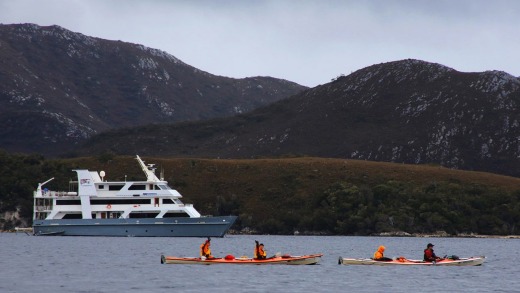
The well-used tender vessel "Explorer" is the key to the expeditionary nature of the cruise. She is raised and lowered by a clever hydraulic hoist system at the stern and can motor close to towering cliffs and sea life, and land on secluded beaches. Each cruise also includes an expert excursion team and we are escorted, educated and entertained by marine biologist Mike Sugden and William Oliver, a discovery officer with Tasmanian Parks and Wildlife. No bird, amphibian, reptile, mammal or large lump of kelp goes unexplained and no geological feature is left unturned as Mike and William bring the knowledge.
The weather forces quite a few changes to the planned itinerary and we have to dump the two-day sojourn to the World Heritage-listed Tasmanian wilderness around Port Davey on the south-west coast completely. As captain Nathan tells us: "The ship would have made it no worries but you all would have hated me by the time we got there."
While this news is greeted with both disappointment and elation (largely a function individual constitutions) the Port Davey sector of the itinerary promises much for future, fairer-weather trips. Accessible only by boat, plane or seven-day trek, this pristine landscape of gorges, rivers and quartzite sand shorelines is also where you can breathe the world's cleanest air. The coastline there is so spectacular Matthew Flinders noted in 1798: "The mountains ... were amongst the most stupendous works of nature I ever beheld."
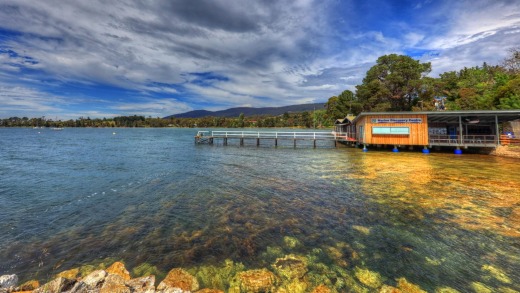
The surviving itinerary is still impressive. We visit Woodbridge School Marine Discovery Centre and learn about Tasmania's incredibly diverse marine species and the fragile ecosystem that supports them. About 90 per cent of Tasmania's marine life is unique and a lot of it is endangered.
It's better news at Grandvewe, a sheep's milk cheesery at Birchs Bay. French cheesemaker and raconteuse Pauline Treilliard is sporting a "STRONG WOMAN worth many sheep" T-shirt as she explains the process from milking to vats to maturation in an accent magnifique. We meet the Awassi ewes and sample their wares as Pauline provides tasting notes with consummate savoir faire. The Blue Sapphire with a pinot paste chaser is a highlight as is Grandvewe's "ewenique" Vanilla Whey Liqueur.
Other landings include Cockle Creek in Recherche Bay on the edge of Southwest National Park, where a French explorer – Bruni D'Entrecasteaux – brought a scientific expedition in 1772 and picturesque Adventure Bay on the eastern side of Bruny Island. Here, a three-hour walk on Fluted Cape ends at the Bligh Museum, commemorating the nautical adventures of Freycinet, Cook and Bligh, all of whom anchored nearby.
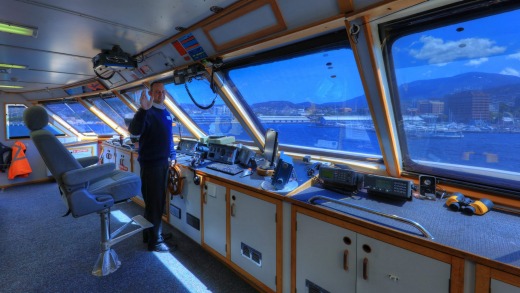
Adventure Bay beach would be lovely for a swim or a kayak in warmer weather.
An enlightening feature of all Coral Expeditions' tours is their Open Bridge policy. If the door is open – and it usually is – you are welcome to come in, have a chat and get a captain's eye view. The 200-metre wide pass between Tasman Island and the towering, multi-coloured dolerite cliffs of the mainland is a great time to take up the offer. Safely through the pass, we turn to port and the wind whips the spray off the top of the waves. The CE I rollercoaster is back in action.
In Pirates Bay we pass the Narrows, a sliver of land along which Port Arthur escapees ran the gauntlet of vicious dogs. Statues of the beasts now stand guard in their stead. We come ashore and explore a tessellated pavement rock formation, and Mike leads the tour and rattles off Latin names and fascinating stories about the kelp, shellfish, molluscs, anemones, birdlife, geology and evolutionary tidal pools. It's like listening to three David Attenboroughs at once.
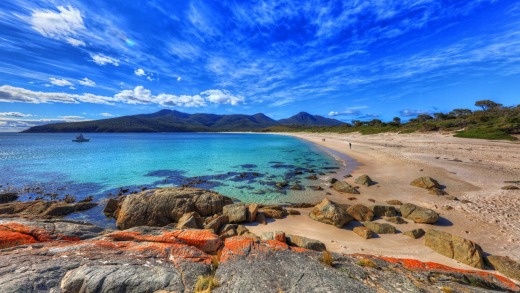
There's more spectacular orange granite coastline on the way to Freycinet Peninsula and Wineglass Bay, regularly listed as one the world's great beaches. An early morning 10-kilometre trek takes the intrepid across the Freycinet Peninsula to the celebrated Wineglass Bay lookout and down to the beach.
We run into more heavy swells and gale-force winds on the run along the east coast of Freycinet to Maria Island and most passengers retreat to their cabins to ride it out. The weather also turns our late-afternoon, wildlife-rich hike on Maria into a next-day, mid-morning, mostly animal-free encounter.
We see a few pademelons in the scrub and some cape barren geese hunkered down against the wind, along with birds on the wing as we pause atop the howling cape of Painted Cliffs. On a good day you are likely to find a whole lot more – as the preponderance of dried poo would suggest – as Maria Island is a modern day Noah's Ark, used as a refuge for several endangered species. We pass a creek and hear a frog croak – and find there's an app for that. William whips out his phone and uses Frog Log to identify it.
Maria is also home to Fossil Cliffs, where a sandstone quarry reveals a plethora of 290-million-year-old fossils as well as several heritage buildings, including an old penitentiary and the somewhat ambitiously named Coffee Palace, where displays and recorded reminiscences chronicle the island's history.
On the way back to Port Arthur, captain Nathan nudges the bow of CE I into Waterfall Bay, where chasm-filled cliffs rise vertically out of the water. A little further on at Fortescue Bay, Explorer takes us to within just a few metres of the cliffs and a shipwreck near the shore. We are also engaged by a pod of dolphins and see seals basking on rock ledges, casually waving their flippers. An hour later we see humpback whales, one within metres of the ship, and our morning is complete.
At Port Arthur Historic Site, our guide Colin Knight parses the horrific story of the 72,000 "incorrigible" convicts sent to Van Diemen's Land. The prison system was known as 'The Machinery', the pinnacle of which was the Separate Prison, where convicts were subjected to inhuman solitary confinement. The walking tour and Colin's comprehensive narrative builds an appetite for a private function at the Magistrate's House supping local Bream Creek wines and some of the finest canapes and oysters imaginable.
A late addition to the itinerary is a trip up the Huon River to the town of Franklin, where we visit the very impressive Wooden Boat Centre and learn about the timbers of Tassie, including the huon pine, which is no longer logged, grows a millimetre a year and sells for about $10,000 a cubic metre. See it if you get the chance and drop in for a tasting at Frank's Cider Bar across the road.
While the weather – and that grumpy sea – may affect what you do on this innovative Tassie cruise, there is much to see and you will never be bored.
And the panorama is truly stunning. As our expedition leader Denis observed when the sea was particularly indignant on one sector: "It can get worse than this but not very often. But how good is this scenery?" And he is right.
Coral Expeditions' southern Tasmanian cruise is an extensive exploration with an intrepid itinerary. If you have the stomach for it.
www.coralexpeditions.com
All major domestic airlines fly daily to Hobart.
Seven-night cruises start at $3990 a person twin share, including excursions and Captain's events, all meals, port and park charges and guest lecturers on board. Phone 1 800 079 545; see www.coralexpeditions.com.